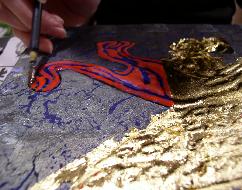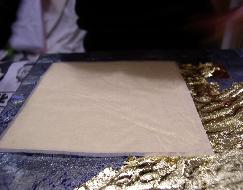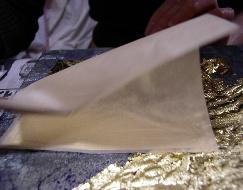NIHONGA
- JAPANESE-STYLE PAINTING (Japanese painting)
"Japanese-style
painting" is the pictures using traditional skill and material
of Japan.What mainly ground a natural minerals is used as paints,
and glue is used as adhesives.Mineral colors are grind or heat to
change the tone of their natural color.Metal foil, powder, shell powder,
soil, others are used.It's paint on various things, such as Japanese
paper (very long and strong fiber) , silk, board and others.
IWAENOGU
Prior to the introduction of IWAENOGU, the materials
used are made from natural ores. There are a number of different grades
of powder, which vary in coarseness, from that of very fine sand to
clay. Iwaenogu materials are sold commercially in Japan. The finest
of these is known as BYAKU(whitish). There are many other types -
almost too many to count. The powders are mixed with glue before use.
These materials are also called GANSAI, rock-paint natural pigments.
For example,
blue : azurite
red : mercury sulfide, coral
green : malachite
white : powder of oyster shell, crystal
DEI
The DEI is used
to give the metallic aspect of gold, silver or platium.
HAKU
The very thin
foils of pressed metal. That is in the market by 10 to 13cm square.
For example: Pure gold, platinum, silver, copper or aluminum.
TECHNIQUE OF THE HAKU
2 or 3 drops of oil on a newspaper fold in four.
Presser with a tow to spread the oil.
Put a thin paper on the newspaper and to let it moisten the oil.
Transfer this paper on the HAKU with a pincette of bamboo.
Then put a little NIKAWA with a brush on the painting support.
Take the paper and the HAKU, and to put then with precision without
making bubble, well positioned, to withdraw the lubricated paper finely.
 |
|
 |
1. apply glue |
|
2. put HAKU and thin paper on it |
 |
|
 |
3. remove the paper |
|
4. fix by cotton pad |
SUNAGO
To
give a decorative aspect to the HAKU, we press it on a sifter that
lets escape of the irregular grains.
|



